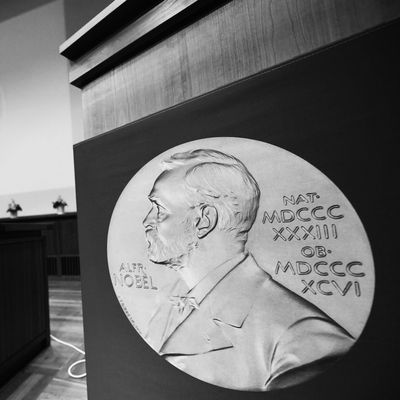
Yesterday, the New York Times published a story about alleged sex trafficker and cartoon villain Jeffrey Epstein’s plan to “seed the human race with his DNA” by impregnating 20 women at once at his New Mexico ranch. According to one scientist, he got his idea from the Repository for Germinal Choice, a sperm bank that was designed to collect the sperm of Nobel Prize winners in order to fill the world with their genius offspring.
Wait — what?
While it sounds like something out of the movie Gattaca, the “Nobel Prize Sperm Bank” really was operational for 20 years, from 1979 to 1999, and based in Escondido, California. It was founded by the multimillionaire optometrist and inventor Robert Graham, an admirer of eugenics who believed the human race was getting progressively dumber and that the only way to stop it was by filling the world with the genetic descendants of Nobel Prize winners. As part of his utopian vision (or dystopian vision, depending on how you look at it), he also planned to recruit only married heterosexual women of a certain IQ to carry these special offspring. Graham touted his sperm bank in the press as his plan to save mankind, which provoked shock and outrage; while eugenics had been popular in the United States at the beginning of the 20th century, it had long since fallen out of favor.
By the time public furor erupted, Graham had collected sperm from three Nobel laureates. Two responded to the criticism by pulling out (ahem, sorry) and their names remain unknown. The third, scientist William Shockley, was an outspoken white supremacist who praised Hitler’s eugenics policies and believed that black people were intellectually inferior to white people. After the PR fallout — which even included a mocking SNL skit called “Dr. Shockley’s House of Sperm” — Graham started recruiting donors elsewhere, and many of the donors’ identities remain a mystery to this day.
In 2001, journalist David Plotz began an investigation for Slate into the donors of Graham’s clinic, and what had happened to their prized semen. (He riffs that he earned the nickname the Semen Detective, and later published a book on it, titled The Genius Factory). All in all, not a single baby ended up inheriting Nobel DNA, yet 217 kids in total were born from the sperm bank. Each donor was identified in sperm-bank catalogues by a color — fuschia no. 1, for example, or coral no. 36. After Plotz put out his call on Slate, he began publishing articles like “A Mother Searches for ‘Donor White,’” connecting with kids looking for their dads, as well as starting to reach the men who had donated to Graham’s sperm bank.
What he discovered was that just a few of the donors had produced a whole lot of offspring; for instance, one donor had produced as many as 30 kids, and that was just the ones Plotz knew about. He also found that the donors had been kind of a mixed bag. One man had falsely gotten into the bank by claiming to have an IQ of 160; another was the unremarkable son of a Nobel Prize winner; another was an Olympic gold medalist. As it turns out, after he failed to get the Nobel-winning sperm he sought, Graham began searching for donors on college campuses and recruiting young scientists, as well as hunting for “Renaissance men … donors who were younger, taller, and better looking than the laureates.” (In keeping with the sperm bank’s eugenicist legacy, all of the men were white). By the mid-1980s, Graham was accepting pretty much anyone who volunteered. “Forget about Nobel laureates; the Nobel sperm bank was taking men you wouldn’t wish on your ex-girlfriend,” Plotz writes. Ultimately, the sperm bank became kind of a scam, with women continuing to seek its services based on an illusory reputation that it couldn’t live up to.
If you’re still wondering whether you can get your hands on any of this mystery sperm, I’m afraid you’re out of luck; the bank closed in 1999, shortly after Graham’s death, and the frozen vials of sperm were incinerated.
Still, Graham’s sperm bank has a lasting legacy. As Plotz notes, Graham was the first sperm banker to “market” his men by touting their attributes in a catalogue, doing “for sperm what Sears, Roebuck did for housewares.” Other sperm banks began to follow in his footsteps, and today’s world of sperm donation continues to follow Graham’s model, launching a “consumer revolution” in fertility, where, for instance, you can pay $12 to see a 26-page handwritten application, and $25 can give you access to an audio interview. Today, there are fewer and fewer secrets in sperm donation, and there continue to be shades of the dystopian in our world of increasing reproductive choice. Yet one of the greatest legacies of sperm banks now is enabling gay couples and single women to become parents — a far cry from Graham’s eugenicist vision.
“The Repository for Germinal Choice pioneered sperm banking but ended up in a fertility cul-de-sac,” writes Plotz. “Other sperm banks took Graham’s best ideas — donor choice, donor testing, and high-achieving donors — and did them better. They offered more choice, more testing, more men. And they managed to do so without Graham’s peculiar eugenics theories, implicit racism, and distaste for single women and lesbians. The repository died because no one needed it anymore. But the dream the repository represented is more alive than ever.”

